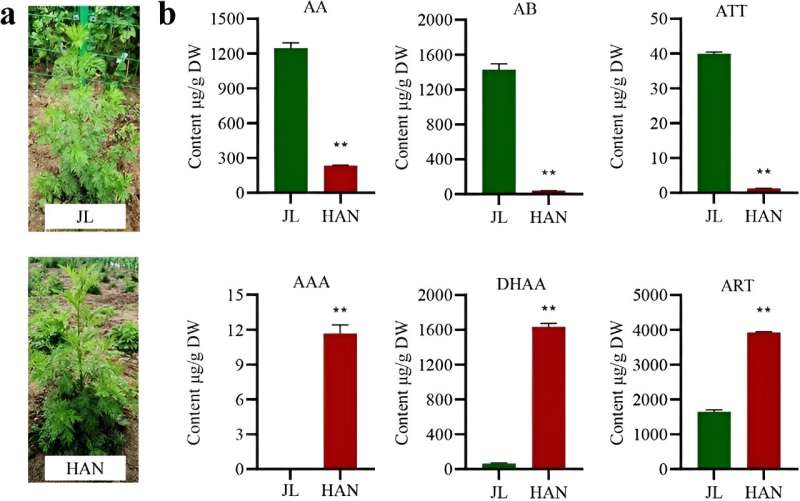This article has been reviewed according to Science X's editorial process and policies. Editors have highlighted the following attributes while ensuring the content's credibility:
fact-checked
proofread
Unlocking artemisinin production secrets in Artemisia annua: The role of DBR2-like gene variations

Artemisia annua is the only known plant source of potent antimalarial artemisinins, and its chemotypes are classified as low- and high-artemisinin producing (LAP and HAP). However, the different mechanisms of artemisinin production by these two chemotypes are still not fully understood.
Despite progress in identifying key enzymes and transcription factors, the precise mechanisms driving the variability in artemisinin content remain unclear, highlighting the importance of further research to enhance production and meet global needs.
In August 2023, Horticulture Research published a study titled "Promoter variations in DBR2-like affect artemisinin production in different chemotypes of Artemisia annua."
In this study, differences in artemisinin biosynthesis between the LAP chemotype JL and the HAP chemotype HAN of Artemisia annua were systematically compared through comprehensive analyses of genome resequencing, metabolomic and transcriptomic data. Metabolite analysis revealing that HAN accumulated significantly more sesquiterpenes and artemisinin-related compounds than JL.
This analysis revealed that the DBR2-Like (DBR2L) gene was highly homologous to the DBR2 gene and speculated to be involved in artemisinin biosynthesis. Subsequent genome resequencing highlighted considerable sequence variations in the DBR2L promoter across different A. annua varieties, which were categorized into three distinct types.
In addition, the core region (-625 to 0) of the DBR2L promoter was identified and candidate transcription factors involved in the regulation of DBR2L were screened. The variations in the DBR2L promoter affects its expression levels, which may lead to different artemisinin production in Artemisia annua varieties.
Metabolomic and transcriptomic analyses further supported these findings by illustrating a higher accumulation of sesquiterpenes in HAN compared to JL and identifying significant differences in the expression of genes involved in terpenoid backbone biosynthesis and sesquiterpene synthesis.
Notably, the DBR2L gene was found to be highly expressed in HAN, and functional assays confirmed its role in converting artemisinic aldehyde to dihydroartemisinic aldehyde, akin to DBR2's activity. This high expression level of DBR2L in HAN correlates with the chemotype's increased artemisinin production.
Taken together, these findings underscore the complex interplay between genetic and metabolic factors underlying artemisinin biosynthesis in A. annua, and provide new insights into the mechanisms underlying the differences in artemisinin production between the LAP and HAP chemotypes of Artemisia annua and will contribute to the enhancement of artemisinin production.
More information: Xingwen Wang et al, Promoter variations in DBR2-like affect artemisinin production in different chemotypes of Artemisia annua, Horticulture Research (2023). DOI: 10.1093/hr/uhad164
Provided by TranSpread




















